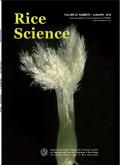Enhancing Folate Content in Japonica Rice Through Co-expression of OsADCS and OsGTPCHI Indica Alleles
IF 6.1
2区 农林科学
Q1 AGRONOMY
引用次数: 0
Abstract
Rice is a poor source of folate, an essential micronutrient for the body. Biofortification offers an effective way to enhance the folate content of rice and alleviate folate deficiencies in humans. In this study, we confirmed that OsADCS and OsGTPCHI, encoding the initial enzymes necessary for folate synthesis, positively regulate folate accumulation in knockout mutants of both japonica and indica rice backgrounds. The folate content in the low-folate japonica variety was slightly increased by the expression of the indica alleles driven by the endosperm-specific promoter. We further obtained co-expression lines by stacking OsADCS and OsGTPCHI genes; the folate accumulation in brown rice and polished rice reached 5.65 μg/g and 2.95 μg/g, respectively, representing 37.9-fold and 26.5-fold increases compared with the wild type. Transcriptomic analysis of rice grains from six transgenic lines showed that folate changes affected biological pathways involved in the synthesis and metabolism of rice seed storage substances, while the expression of other folate synthesis genes was weakly regulated. In addition, we identified Aus rice as a high-folate germplasm carrying superior haplotypes of OsADCS and OsGTPCHI through natural variation. This study provides an alternative and effective complementary strategy for rice biofortification, promoting the rational combination of metabolic engineering and conventional breeding to breed high-folate varieties.
通过表达OsADCS和OsGTPCHI等位基因提高粳稻叶酸含量
大米缺乏叶酸,而叶酸是人体必需的微量营养素。生物强化是提高水稻叶酸含量和缓解人类叶酸缺乏的有效途径。在这项研究中,我们证实了OsADCS和OsGTPCHI编码叶酸合成所需的初始酶,在粳稻和籼稻背景的敲除突变体中积极调节叶酸积累。在胚乳特异性启动子驱动下,籼型等位基因的表达使低叶酸品种的叶酸含量略有增加。我们进一步通过堆叠OsADCS和OsGTPCHI基因获得共表达系;糙米和精米的叶酸积累量分别达到5.65和2.95 μg/g,分别是野生型的37.9倍和26.5倍。对6个转基因水稻株系的转录组学分析表明,叶酸的变化影响了水稻种子贮藏物质合成和代谢的生物学途径,而其他叶酸合成基因的表达受到弱调控。此外,我们通过自然变异鉴定出Aus水稻是一种高叶酸种质,携带OsADCS和OsGTPCHI的优良单倍型。本研究为水稻生物强化提供了一种替代和有效的补充策略,促进代谢工程与常规育种的合理结合,培育高叶酸品种。
本文章由计算机程序翻译,如有差异,请以英文原文为准。
求助全文
约1分钟内获得全文
求助全文
来源期刊

Rice Science
Agricultural and Biological Sciences-Agronomy and Crop Science
CiteScore
8.90
自引率
6.20%
发文量
55
审稿时长
40 weeks
期刊介绍:
Rice Science is an international research journal sponsored by China National Rice Research Institute. It publishes original research papers, review articles, as well as short communications on all aspects of rice sciences in English language. Some of the topics that may be included in each issue are: breeding and genetics, biotechnology, germplasm resources, crop management, pest management, physiology, soil and fertilizer management, ecology, cereal chemistry and post-harvest processing.
 求助内容:
求助内容: 应助结果提醒方式:
应助结果提醒方式:


